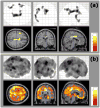A two-year follow-up of cognitive deficits and brain perfusion in mild cognitive impairment and mild Alzheimer's disease
- PMID: 22406443
- PMCID: PMC3589736
- DOI: 10.3233/JAD-2012-111850
A two-year follow-up of cognitive deficits and brain perfusion in mild cognitive impairment and mild Alzheimer's disease
Abstract
The 15-Objects Test (15-OT) provides useful gradation of visuoperceptual impairment from normal aging through Alzheimer's disease (AD) and correlates with temporo-parietal perfusion. The objectives of this study were to analyze progression of 15-OT performance in mild cognitive impairment (MCI) and AD, and its correlates with cognition and single photon emission computerized tomography (SPECT), as well as to examine neuropsychological and SPECT differences between the MCI patients who developed AD and those who did not. From the initial 126 participants (42/group), 38 AD, 39 MCI, and 38 elderly controls (EC) were reassessed (SPECT: 35 AD, 33 MCI, 35 EC) after two years. The progression of cognitive and SPECT scores during this period was compared between groups, and baseline data between converters and non-converters. The 15-OT was the only measure of progression that differed between the three groups; worsening scores on 15-OT were associated with worsening in verbal and visual retention, and decreased perfusion on left postsubicular area. In the MCI patients, cerebral perfusion fell over the two years in medial-posterior cingulate and fronto-temporo-parietal regions; AD showed extensive changes involving almost all cerebral regions. No SPECT changes were detected in controls. At baseline, the MCI patients who developed AD differed from non-converters in verbal recognition memory, but not in SPECT perfusion. In conclusion, SPECT and 15-OT appear to provide a potential measure to differentiate between normal aging, MCI, and AD. Worsening on 15-OT was related to decreased perfusion in postsubicular area; but further longitudinal studies are needed to determine the contribution of 15-OT as a predictor of AD from MCI.
Figures



Similar articles
-
Brain perfusion correlates of visuoperceptual deficits in mild cognitive impairment and mild Alzheimer's disease.J Alzheimers Dis. 2010;21(2):557-67. doi: 10.3233/JAD-2010-091069. J Alzheimers Dis. 2010. PMID: 20555146 Free PMC article.
-
Cognitive, genetic, and brain perfusion factors associated with four year incidence of Alzheimer's disease from mild cognitive impairment.J Alzheimers Dis. 2014;41(3):739-48. doi: 10.3233/JAD-132516. J Alzheimers Dis. 2014. PMID: 24685632 Free PMC article.
-
Brain perfusion SPECT with an automated quantitative tool can identify prodromal Alzheimer's disease among patients with mild cognitive impairment.Neurobiol Aging. 2011 Jan;32(1):15-23. doi: 10.1016/j.neurobiolaging.2009.01.013. Epub 2009 Feb 27. Neurobiol Aging. 2011. PMID: 19250707 Clinical Trial.
-
Functional Neural Correlates of Anosognosia in Mild Cognitive Impairment and Alzheimer's Disease: a Systematic Review.Neuropsychol Rev. 2019 Jun;29(2):139-165. doi: 10.1007/s11065-019-09410-x. Epub 2019 Jun 3. Neuropsychol Rev. 2019. PMID: 31161466 Free PMC article.
-
Systematic review and meta-analysis of diagnostic test accuracy (DTA) studies: the role of cerebral perfusion imaging in prognosis evaluation of mild cognitive impairment.Ann Palliat Med. 2022 Feb;11(2):673-683. doi: 10.21037/apm-21-3916. Ann Palliat Med. 2022. PMID: 35249345
Cited by
-
From Face-to-Face to Home-to-Home: Validity of a Teleneuropsychological Battery.J Alzheimers Dis. 2021;81(4):1541-1553. doi: 10.3233/JAD-201389. J Alzheimers Dis. 2021. PMID: 33935075 Free PMC article.
-
Increase of theta frequency is associated with reduction in regional cerebral blood flow only in subjects with mild cognitive impairment with higher upper alpha/low alpha EEG frequency power ratio.Front Behav Neurosci. 2013 Dec 5;7:188. doi: 10.3389/fnbeh.2013.00188. eCollection 2013. Front Behav Neurosci. 2013. PMID: 24367305 Free PMC article.
-
Amyloid deposition and CBF patterns predict conversion of mild cognitive impairment to dementia.Neurol Sci. 2018 Sep;39(9):1597-1602. doi: 10.1007/s10072-018-3477-0. Epub 2018 Jun 23. Neurol Sci. 2018. PMID: 29936556
-
Characteristics of Regional Cerebral Blood Flow in Alzheimer Disease and Amnestic Mild Cognitive Impairment by Single-Photon Emission Computerized Tomography: A Cross-Sectional Study.Dement Geriatr Cogn Dis Extra. 2021 May 6;11(2):91-98. doi: 10.1159/000515864. eCollection 2021 May-Aug. Dement Geriatr Cogn Dis Extra. 2021. PMID: 34178012 Free PMC article.
-
Diffusion tensor tractography-based analysis of the cingulum: clinical utility and findings in traumatic brain injury with chronic sequels.Neuroradiology. 2014 Oct;56(10):833-41. doi: 10.1007/s00234-014-1410-7. Epub 2014 Jul 31. Neuroradiology. 2014. PMID: 25080234
References
-
- Small BJ, Gagnon E, Robinson B. Early identification of cognitive deficits: preclinical Alzheimer’s disease and mild cognitive impairment. Geriatrics. 2007;62:19–23. - PubMed
-
- Bäckman L, Small BJ, Fratiglioni L. Stability of the preclinical episodic memory deficit in Alzheimer’s disease. Brain. 2001;124:96–102. - PubMed
-
- Amieva H, Jacqmin-Gadda H, Orgogozo JM, Le Carret N, Helmer C, Letenneur L, Barberger-Gateau P, Fabrigoule C, Dartigues JF. The 9 year cognitive decline before dementia of the Alzheimer type: a prospective population-based study. Brain. 2005;128:1093–1101. - PubMed
-
- Levinoff EJ, Saumier D, Chertkov H. Focused attention deficits in partients with Alzheimer’s disease and mild cognitive impaiment. Brain Cogn. 2005;57:127–130. - PubMed
-
- Tales A, Haworth J, Nelson S, Snowden RM, Wilcock G. Abnormal visual search in mild cognitive impairment and Alzheimer’s disease. Neurocase. 2005;11:80–84. - PubMed
Publication types
MeSH terms
Grants and funding
LinkOut - more resources
Full Text Sources
Medical

